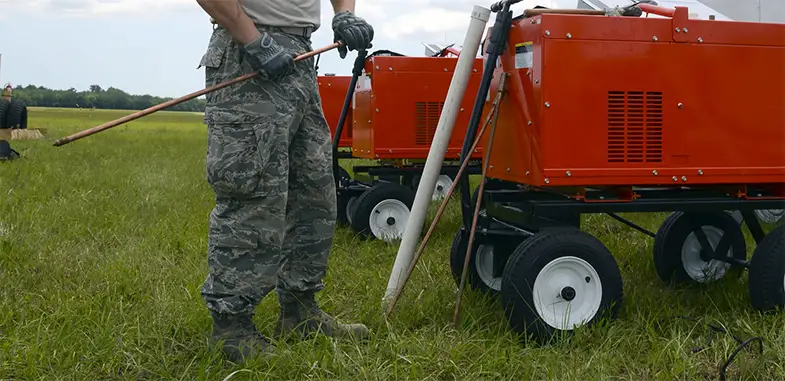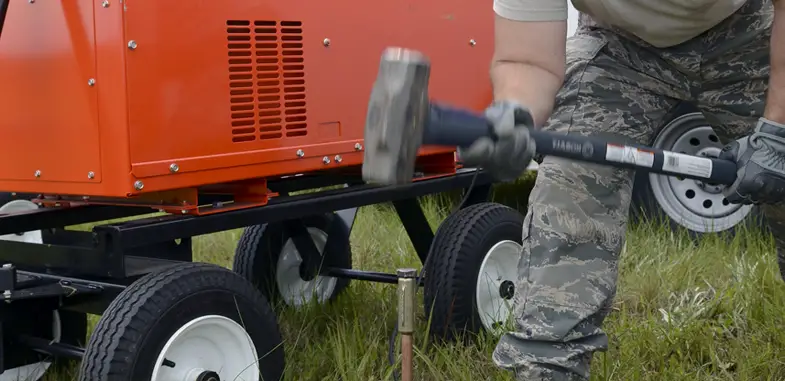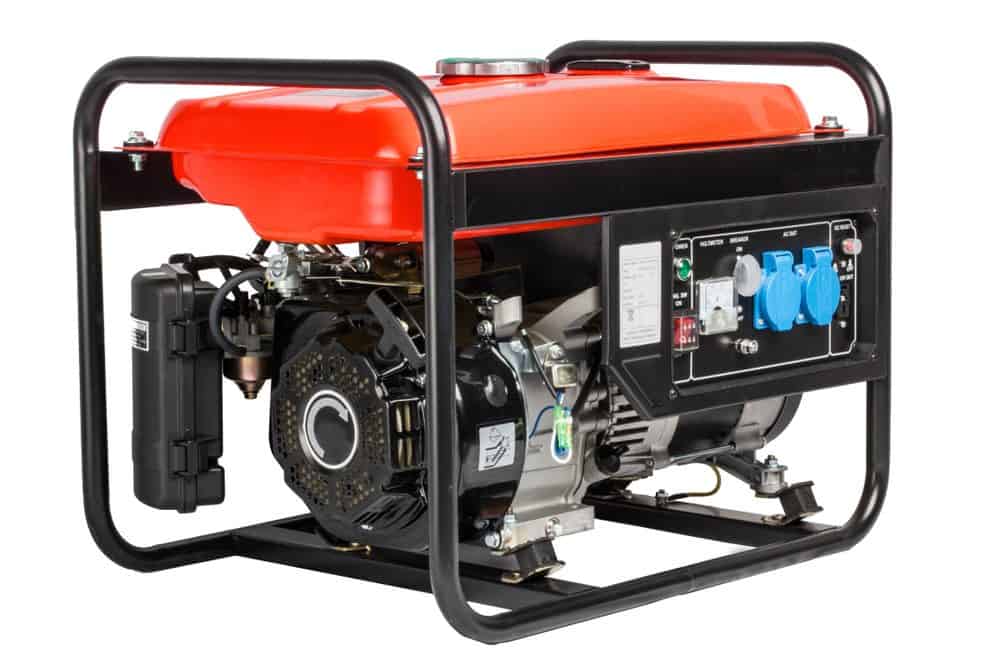We love the freedom that a portable generator can provide- and with that freedom comes the responsibility to keep safety as the number one priority.
Portable generators are relatively safe compared to other tools with motors in them, there are still some critical safety considerations to keep in mind if you want to ground a generator. One of the most important of these is recognizing whether your generator needs to be grounded and understanding how to ground a generator.
Not all portable generators need to be grounded, and some may only need to be grounded in specific circumstances. In this article, we’ll cover what grounding is, how to tell if you need to ground your portable generator, and explain how to do it in the safest way.
Table of Contents
The Importance of Grounding a Generator
When electricity is flowing through a set of wires, it is always seeking to dissipate energy by returning to a ground. In a normal electrical system, like that of your generator, electricity flows through “hot” wires to a series of neutral wires.
But, if anything happens to that normal electrical circuit, electricity will flow through the path of least resistance. If your generator isn’t grounded, that path of least resistance could allow electricity to flow in places it shouldn’t be – which can cause electrocution, spark a fire, or cause other dangerous situations.
Grounding provides a backup path of least resistance for electricity to flow. The term grounding is used because in many electrical systems, that backup path leads directly into the ground where it can pose relatively little risk.

Does portable generator need to be grounded?
All portable generators need to be grounded in order to be safe. But, whether you need to do anything special to ground your generator depends on how it was designed.
Most modern portable generators are designed such that the metal frame around the generator acts as the path of least electrical resistance. In this case, the engine, fuel tank, and generator housing are all bonded to the frame, so that any electricity flowing through the generator outside of the wiring is grounded by the frame.
The easiest way to tell if your generator needs to be grounded is to check your owner’s manual. The manufacturer should provide extremely clear instructions on whether or not your generator needs to be grounded.
If you don’t have the manual or it is not clear, you can also inspect the construction of your generator. If the generator’s transfer switch gives you the option to transfer current to a neutral ground conductor, your generator’s components consist of a separately derived system. This means you will need to connect your generator to a separate grounding rod.
How to Ground Your Portable Generator
If you find that you need to ground your portable generator, you’ll need to wire your generator’s transfer switch to a grounding rod.

Tools and Equipment To Ground Your Generator
You’ll need to have the following equipment on hand to ground your generator- it’s possible to buy a generator grounding kit- but here’s all you need:
- Copper Grounding Rod – A copper grounding rod is designed to be driven into the ground, where any electrical current can be safely dissipated. For most portable generators, you’ll need a copper rod that is at least four feet in length, although a longer rod can make driving it deeper into the ground easier.
- Copper Grounding Wire – Copper grounding wire will be used to connect the grounding bolt on your generator to the grounding rod. The amount of wire that you need will depend on the distance between your generator and your buried rod. Be sure to give yourself some extra wire since this can make driving the rod into the ground easier.
- Wire Strippers, Pliers, and Wrench – These tools will be used to strip the copper grounding wire and to connect it to the grounding rod and your generator’s grounding bolt.
- Hammer or Mallet – You’ll need a heavy, blunt object to drive the copper grounding wire into the ground. Depending on the terrain, a shovel or spike may also come in handy.

Step 1: Hammer in the Copper Grounding Rod
The copper rod should be hammered into the ground or buried at least 8 feet deep (although you can buy a 4 foot rod, but 8 is standard for home installations). This depth ensures that any electrical discharge from the grounding rod won’t electrocute people standing on the surface. If you are in rocky or difficult terrain, the rod can be hammered in at an angle of up to 45 degrees.

Step 2: Connect Copper Wire to Grounding Rod
Use your wire strippers to strip out about six to 12 inches of insulation off one end of the copper wire. Then wrap this around the top of the grounding rod, using your pliers to make sure it is wound tightly around the rod.
Step 3: Connect the Generator to the Grounding Rod
You can connect your generator to the grounding rod using the other end of your copper wire. The generator should be turned off when you do this.
Locate the grounding bolt on your generator and loosen the nut slightly. Strip the end of the copper wire one to two inches and then wrap it around the grounding bolt with your pliers. When done, tighten the nut to ensure the wire remains firmly in place.
Should You Ground a Portable Generator?
Most modern generators are designed as a single system, such that the frame serves to ground the generator. But, if you find that your generator requires an external ground, grounding it properly is an extremely important part of safe generator operation.
Grounding your portable generator can be fast and simple once you have the right tools on hand. Once it’s grounded, you can operate your generator without worrying about potential electrocution in the event of an electrical failure.
Portable generators are very handy pieces of equipment. They can be used for a range of tasks in different settings.
These impressive machines can act as backups for when your electricity supply is cut off, as well as, power many electrical devices at once. Although generally safe to use, some instances will require your generator to be properly grounded.
A well-grounded generator will add another layer of safety when you’re out on your camping trip. This can depend on the surface and terrain you are camping on.
The last thing you need is your generator short-circuiting and breaking, leaving you without any power whatsoever. To ground a generator safely and securely, we have made a helpful guide to do some handy tips to understand the best process.
Let’s not wait around! Find out the best way to ground a generator below!

How to ground a generator when you are camping
With most portable generators, its frame will act as the ground. This means you won’t have to use any metal rods and hammer them around the generator for proper grounding.
On the other hand, if you want to be extra cautious, you should use an 8-foot rod as this follows the safety code.
As we mentioned, grounding your generator will add extra support and safety. A well-grounded generator will reduce the risk of electrocution as well as electrical failure.
A generator’s composition works like an electrical circuit. This is why it requires a correctly installed rod as this works as the reference ground. Connecting a copper wire from the generator’s composition to the grounding rod will safely ground the generator.
To properly ground a generator, you need to make sure you have the correct utilities to do so safely. These include:
- Copper Rod – This will ground your portable generator. This should be at least 4-foot long and no less. A longer copper grounding rod may help penetrate the ground for a more sturdy grounding. This will usually have to be hammered into the ground if you are camping on tough terrain
- Copper wire – Stripping the copper wire will allow you to connect the copper grounding rod and become a conductive electrical cable
- Copper grounding wire – This connects the grounding pin from your generator to the copper grounding rod. The amount of cable needed to make the ground connection depends on the generators distance between the buried rod
- Pair of pliers – These are used to twist the copper wire near the grounding rod for a good connection between both
- Wire strippers – If your generator has an insulated grounding wire (most do), you will need to strip off the insulation on either end. This is easier with wire strippers as you can connect it to the grounding wire’s copper wire and the generator
- Wrench – Once the grounding wire is stripped, it must be connected to the generator. You will need a wrench to loosen a nut or two
If you’re dealing with separate grounding, you must make sure the ground and link circuits are of low resistance. It is advised you use the resistance of 0.2 ohms or less on your metal rod and grounding wire. Also, ensure the link connection is able to conduct electricity if a short circuit occurs
Step 1
Before grounding your generator, you need to make sure the ground is completely dry. Never try grounding your generator in wet conditions.
Ensure your hands are dry, find a dry area on the ground, and shelter the space from any possible moisture.
Step 2
Install the copper rod on the floor by sinking it at least 8 feet into the ground using a hammer. If you dip the rod with more pressure, it should ground far better.
If the ground is too hard to penetrate, pour some water and wait for the ground to soften. When the surface has dried, sink the rod in at no more than a 45-degree angle.
Step 3
Ensure the copper wire is laid well away from your campsite. Peel the copper wire at both ends with your wire stripper. Make sure you leave most of the wire bare.
Step 4
Once the grounding rod is 4 feet down, you need to connect the copper wire. With the pliers, wrap the copper wire tightly near the copper ground rod.
Step 5
Once the copper rod is set at least 8 feet into the ground, you need to wrap the copper wire tightly around it with the pliers.
Step 6
Now you link the other wire you have radical to the portable generator to ground it completely.
Simply loosen the grounding bolt slightly with your wrench, use the key, and wrap the wire around tightly. Then re-tighten the bolt to finish the process.
Your generator is now grounded and safe to use on your camping trip!
Do I need to ground my generator?
It is not always necessary to ground your generator. Most manufacturers bond the components to the generator’s frame which acts as a ground wire for you.
You will need to ground the generator if you are plugging it into a wired circuit system or if you want to plug electrical appliances directly into the generator.
Grounding directs an unwanted voltage from causing damage to your electrical appliances, including your generator. If it is not correctly grounded, a surge of electricity could travel through the different electrical connections and cause damage or even harm.
A properly grounded generator will protect you, your family, and your personal belongings from surges of unexpected power.
This doesn’t mean you have to go through this whole process every time you set up camp, however. Certain situations will require more than the generator’s bonded frame in order to direct dangerous electrical surges away from your campsite.
A proper, well-grounded generator will protect you and your family from getting hurt as well as prevent your personal possessions from getting damaged.
If you set up a generator correctly, there will be no need t


My Predator generator (4375 starting watts) will be sitting in a shed that is 15 feet away from an electrical outlet on the side of my house. The outlet is grounded via the house electrical system. Instead of pounding a copper rod into the ground could I just connect a copper wire to the ground prong of a 3-prong “dummy” plug (nothing connected to the hot or neutral prongs) and then just plug it into the outlet? Would that count as an appropriate ground for my generator? Thanks for your opinion on this.
Yes that should work!
How do I sink a 4 foot rod 8 feet into the ground? I live in Northern California, where the adobe is hard and full of stones. Even if I could somehow dig a 4-foot post-hole, I could never drive a rod into the ground from there because the stones would block its path. (I recently broke a steely mattock head just trying to dig a hole to plant flowers!) My new Predator 3500 generator unequivocally says it needs to be grounded. What should I do?
I would use your 4 feet rod kit and try to pound it in at an angle. Getting all 4 feet in the ground is the most important part.
Sorry, I also live in Northern CA, and agree with the person asking the question. Driving it in in any direction is not an option. Digging a 3’ hole took me over a week with pick ax & other tools, and was only possible when the water table dropped a specific depth and before it dropped any farther. That was in the least rocky part of my property. So, without heavy machinery, and only if a wide surface is dug, is anything but a T-post put into the ground (then requiring special equipment to remove if you need to, since the earth has turned to cement for most of the year). So, any suggestions for other options?
Check out this article to see if you can find any good tips.
https://www.ecmweb.com/content/article/20892049/achieving-an-acceptable-ground-in-poor-soil
I have the ground wire for my (old) house’s electric panel exposed a small bit in front of our house before it runs under the crawl space to the .
Can I just connect to this ground if I set my generator up in the front yard?
Thanks!
That should be okay, but of course consult a licensed electrician first!
I see on Amazon screw in the ground anchors that they say will work as a ground rod. While I have used them to tie a long leash to for my dog, not sure they will provide the necessary ground capabilities for my generator.
What do you think.
It would be better than nothing, but not ideal!